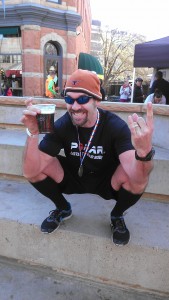This past Sunday I had the pleasure of running the Colorado Half-Marathon in Ft. Collins, CO. My official results are as follows:
- Final time: 01:47:26 at a 00:08:12 pace.
- Overall place: 204 out of 1529 in the HALF MARATHON.
- Division placing: 13 out of 68 in class M35-39.
I’m not too terribly disappointed in those results. I came in in the top 20% of my age group and top 13% overall. That sounds kinda cool… Makes me think I could actually be competitive. Too bad they don’t do standings by weight class. I wonder how I did among men in the 200 lbs. range? I know I could’ve done better though if I’d been a little smarter. More on that in a moment.
Early morning & a perfect day
I couldn’t have asked for better racing weather. It was dry, clear and temps were somewhere in the low 40s at the start. Cold but perfect for a vigorous run. The pre-race meal consisted of some Bulletproof coffee and a bit of beet/celery/apple/cucumber/kiwi/kale juice. About a half-hour before the race I had an old-fashioned Powerbar which always seems to agree with me.
Start time was 6:30 am. Getting up at 4:30-ish was a little tough but being that I get up early most days, it wasn’t anything freakish. Racers boarded buses for a ride up along the Poudre River to the start. The scenery was typical of Colorado’s Front Range: mountainous, beautiful and powerful.
The race: I’ll be smarter next time.
My goal time was 1:47 and change. I did in fact hit my goal time so that’s fine, but the course was a fast course and I thought I could finish faster. (Maybe 1:45? Sounds like a nice almost-round and realistic number.) The big issue is I started off too fast. Every runner who’s ever raced more than one race has done this. The results always confirm that we are just as human as everyone else. No matter how good you feel at the start of a race you’re not going to feel that good at the end. Hold back. Feel like you’re going slow at the start so you can maintain speed at the end. Lesson learned (again.)
I planned on running with a pace group. There was a 1:40 group and a 1:50 group. I started with the 1:40 group with the idea that I’d stay with them just a little while, slow a bit and maintain my goal pace of 8:11/mile. Bottom line, it didn’t work out exactly. I slowed down near the end. If I had it to do over–which I will–I would’ve maintained even splits the whole time. Fortunately, there was beer at the end which in all truth may not be the ideal post-workout/race recovery drink but it still takes a special prize. To paraphrase Robert Duvall in Apocalypse Now: “I love the taste of cold suds in the morning. Tastes like…. I ran 13.1 miles.”
The final word
I have great affection this race. Ft. Collins is a delightful place and I love going there for any reason. If you get a chance to run this race, do it. (There’s a marathon, half-marathon, 10k and 5k–a distance for everyone.) Register early though because the marathon and half- fill up fast.
It’s tempting to think about running the marathon, but training for a spring marathon during the Colorado winter sounds less-than-enjoyable. I’ll have to think on it.


